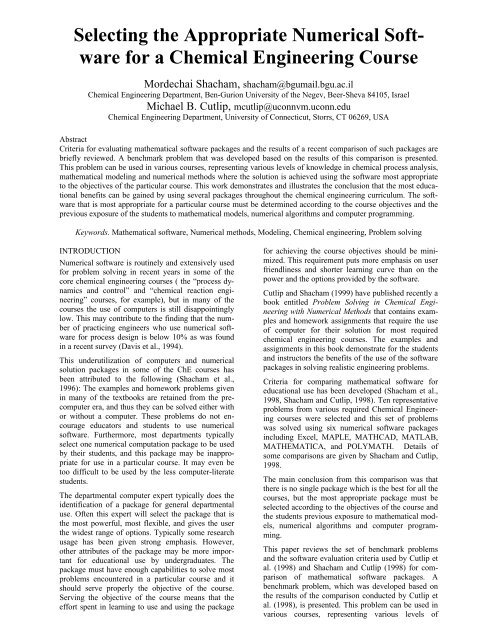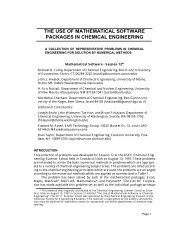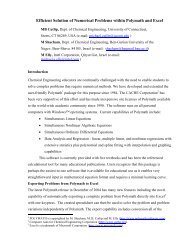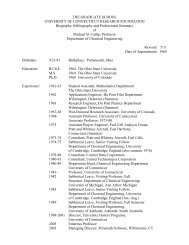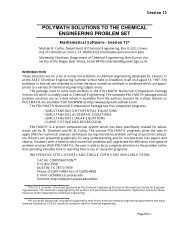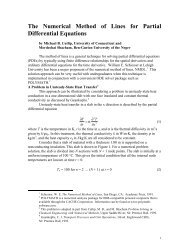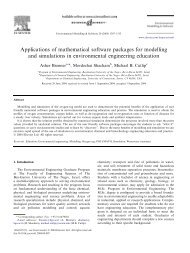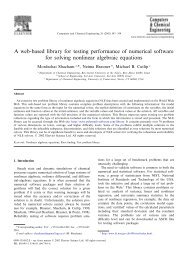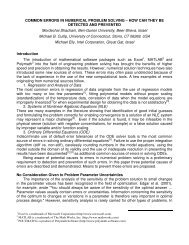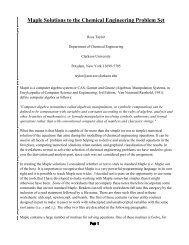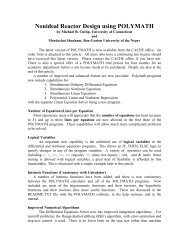Selecting the Appropriate Numerical Soft - Polymath Software
Selecting the Appropriate Numerical Soft - Polymath Software
Selecting the Appropriate Numerical Soft - Polymath Software
Create successful ePaper yourself
Turn your PDF publications into a flip-book with our unique Google optimized e-Paper software.
<strong>Selecting</strong> <strong>the</strong> <strong>Appropriate</strong> <strong>Numerical</strong> <strong>Soft</strong>ware<br />
for a Chemical Engineering Course<br />
Mordechai Shacham, shacham@bgumail.bgu.ac.il<br />
Chemical Engineering Department, Ben-Gurion University of <strong>the</strong> Negev, Beer-Sheva 84105, Israel<br />
Michael B. Cutlip, mcutlip@uconnvm.uconn.edu<br />
Chemical Engineering Department, University of Connecticut, Storrs, CT 06269, USA<br />
Abstract<br />
Criteria for evaluating ma<strong>the</strong>matical software packages and <strong>the</strong> results of a recent comparison of such packages are<br />
briefly reviewed. A benchmark problem that was developed based on <strong>the</strong> results of this comparison is presented.<br />
This problem can be used in various courses, representing various levels of knowledge in chemical process analysis,<br />
ma<strong>the</strong>matical modeling and numerical methods where <strong>the</strong> solution is achieved using <strong>the</strong> software most appropriate<br />
to <strong>the</strong> objectives of <strong>the</strong> particular course. This work demonstrates and illustrates <strong>the</strong> conclusion that <strong>the</strong> most educational<br />
benefits can be gained by using several packages throughout <strong>the</strong> chemical engineering curriculum. The software<br />
that is most appropriate for a particular course must be determined according to <strong>the</strong> course objectives and <strong>the</strong><br />
previous exposure of <strong>the</strong> students to ma<strong>the</strong>matical models, numerical algorithms and computer programming.<br />
Keywords. Ma<strong>the</strong>matical software, <strong>Numerical</strong> methods, Modeling, Chemical engineering, Problem solving<br />
INTRODUCTION<br />
<strong>Numerical</strong> software is routinely and extensively used<br />
for problem solving in recent years in some of <strong>the</strong><br />
core chemical engineering courses ( <strong>the</strong> “process dynamics<br />
and control” and “chemical reaction engineering”<br />
courses, for example), but in many of <strong>the</strong><br />
courses <strong>the</strong> use of computers is still disappointingly<br />
low. This may contribute to <strong>the</strong> finding that <strong>the</strong> number<br />
of practicing engineers who use numerical software<br />
for process design is below 10% as was found<br />
in a recent survey (Davis et al., 1994).<br />
This underutilization of computers and numerical<br />
solution packages in some of <strong>the</strong> ChE courses has<br />
been attributed to <strong>the</strong> following (Shacham et al.,<br />
1996): The examples and homework problems given<br />
in many of <strong>the</strong> textbooks are retained from <strong>the</strong> precomputer<br />
era, and thus <strong>the</strong>y can be solved ei<strong>the</strong>r with<br />
or without a computer. These problems do not encourage<br />
educators and students to use numerical<br />
software. Fur<strong>the</strong>rmore, most departments typically<br />
select one numerical computation package to be used<br />
by <strong>the</strong>ir students, and this package may be inappropriate<br />
for use in a particular course. It may even be<br />
too difficult to be used by <strong>the</strong> less computer-literate<br />
students.<br />
The departmental computer expert typically does <strong>the</strong><br />
identification of a package for general departmental<br />
use. Often this expert will select <strong>the</strong> package that is<br />
<strong>the</strong> most powerful, most flexible, and gives <strong>the</strong> user<br />
<strong>the</strong> widest range of options. Typically some research<br />
usage has been given strong emphasis. However,<br />
o<strong>the</strong>r attributes of <strong>the</strong> package may be more important<br />
for educational use by undergraduates. The<br />
package must have enough capabilities to solve most<br />
problems encountered in a particular course and it<br />
should serve properly <strong>the</strong> objective of <strong>the</strong> course.<br />
Serving <strong>the</strong> objective of <strong>the</strong> course means that <strong>the</strong><br />
effort spent in learning to use and using <strong>the</strong> package<br />
for achieving <strong>the</strong> course objectives should be minimized.<br />
This requirement puts more emphasis on user<br />
friendliness and shorter learning curve than on <strong>the</strong><br />
power and <strong>the</strong> options provided by <strong>the</strong> software.<br />
Cutlip and Shacham (1999) have published recently a<br />
book entitled Problem Solving in Chemical Engineering<br />
with <strong>Numerical</strong> Methods that contains examples<br />
and homework assignments that require <strong>the</strong> use<br />
of computer for <strong>the</strong>ir solution for most required<br />
chemical engineering courses. The examples and<br />
assignments in this book demonstrate for <strong>the</strong> students<br />
and instructors <strong>the</strong> benefits of <strong>the</strong> use of <strong>the</strong> software<br />
packages in solving realistic engineering problems.<br />
Criteria for comparing ma<strong>the</strong>matical software for<br />
educational use has been developed (Shacham et al.,<br />
1998, Shacham and Cutlip, 1998). Ten representative<br />
problems from various required Chemical Engineering<br />
courses were selected and this set of problems<br />
was solved using six numerical software packages<br />
including Excel, MAPLE, MATHCAD, MATLAB,<br />
MATHEMATICA, and POLYMATH. Details of<br />
some comparisons are given by Shacham and Cutlip,<br />
1998.<br />
The main conclusion from this comparison was that<br />
<strong>the</strong>re is no single package which is <strong>the</strong> best for all <strong>the</strong><br />
courses, but <strong>the</strong> most appropriate package must be<br />
selected according to <strong>the</strong> objectives of <strong>the</strong> course and<br />
<strong>the</strong> students previous exposure to ma<strong>the</strong>matical models,<br />
numerical algorithms and computer programming.<br />
This paper reviews <strong>the</strong> set of benchmark problems<br />
and <strong>the</strong> software evaluation criteria used by Cutlip et<br />
al. (1998) and Shacham and Cutlip (1998) for comparison<br />
of ma<strong>the</strong>matical software packages. A<br />
benchmark problem, which was developed based on<br />
<strong>the</strong> results of <strong>the</strong> comparison conducted by Cutlip et<br />
al. (1998), is presented. This problem can be used in<br />
various courses, representing various levels of
knowledge in chemical process analysis, ma<strong>the</strong>matical<br />
modeling and numerical methods where <strong>the</strong> solution<br />
is achieved using <strong>the</strong> most appropriate software<br />
so as to attain <strong>the</strong> objectives of <strong>the</strong> particular course.<br />
A BENCHMARK PROBLEM SET FOR<br />
SOFTWARE PACKAGE EVALUATION<br />
The set of benchmark problems of Cutlip et al.<br />
(1998), which was developed for evaluation of software<br />
packages, is shown in Table 1. Within this set<br />
<strong>the</strong>re are representative problems from almost every<br />
required course in a typical chemical engineering<br />
curriculum. This problem set has been solved with<br />
six software packages. The CACHE Corporation<br />
provides this problem set as well as <strong>the</strong> individual<br />
package write-ups and problem solutions files for<br />
downloading from <strong>the</strong> Internet at<br />
http://www.che.utexas.edu/cache/.<br />
Table 1 – Benchmark Problem Set<br />
Problem Title<br />
1 Molar Volume and Compressibility Factor<br />
from Van Der Waal’s Equation<br />
2 Steady State Material Balances on a Separation<br />
Train<br />
3 Vapor Pressure Data Representation by Polynomials<br />
and Equations<br />
4 Reaction Equilibrium for Multiple Gas Phase<br />
Reactions<br />
5 Terminal Velocity of Falling Particles<br />
6 Unsteady State Heat Exchange in a Series of<br />
Agitated Tanks<br />
7 Diffusion with Chemical Reaction in a One<br />
Dimensional Slab<br />
8 Binary Batch Distillation<br />
9 Reversible, Exo<strong>the</strong>rmic, Gas Phase Reaction in<br />
a Catalytic Reactor<br />
10 Dynamics of a Heated Tank with PI Temperature<br />
Control<br />
CRITERIA FOR SOFTWARE EVALUATION<br />
Shacham et al. (1998) and Shacham and Cutlip<br />
(1998) have suggested <strong>the</strong> following criteria for software<br />
evaluation and comparison:<br />
1. <strong>Numerical</strong> Performance<br />
1.1. Ability to solve all typical benchmark<br />
problems<br />
2. User Friendliness<br />
2.1. Menu versus command based program<br />
control<br />
2.2. Notation and format used in equation entry<br />
2.3. Debugging aids (syntax errors, undefined<br />
or not initialized variables, etc.)<br />
2.4. Equation ordering and detection of implicit<br />
relationships<br />
2.5. Solution verification<br />
3. Technical effort required for:<br />
3.1. Preparation of <strong>the</strong> model<br />
3.2. Documentation of <strong>the</strong> model<br />
3.3. Setting up <strong>the</strong> solution algorithm<br />
3.4. Presentation of <strong>the</strong> results<br />
2<br />
3.5. Documentation of <strong>the</strong> results<br />
3.6. Alteration of <strong>the</strong> model for parametric<br />
studies<br />
Most of <strong>the</strong> above criteria are self-explanatory. More<br />
detailed discussions of <strong>the</strong> various criteria are provided<br />
in <strong>the</strong> references.<br />
SELECTING THE APPROPRIATE SOFTWARE<br />
BASED ON COURSE OBJECTIVES<br />
Our work and experience with ma<strong>the</strong>matical software,<br />
as well as <strong>the</strong> results of <strong>the</strong> comparison that<br />
was described in <strong>the</strong> previous sections, has lead us to<br />
conclude that <strong>the</strong> most educational benefit can be<br />
gained by using several packages throughout <strong>the</strong> curriculum.<br />
The software that is most appropriate for a<br />
particular course must be determined according to <strong>the</strong><br />
course objectives and <strong>the</strong> students previous exposure<br />
to ma<strong>the</strong>matical models, numerical algorithms and<br />
computer programming. The software selection procedure<br />
will be demonstrated in reference to a homework<br />
assignment that is outlined below. The complete<br />
paper including <strong>the</strong> problem statement and detailed<br />
solutions are available on <strong>the</strong> Internet at<br />
http://www.polymath-software.com/papers/.<br />
RIGOROUS DISTILLATION CALCULATIONS BY THE<br />
WANG AND HENKE METHOD - PROBLEM DEFINITION<br />
<strong>Numerical</strong> Methods. Solution of a single nonlinear algebraic<br />
equation, solution of systems of linear algebraic<br />
equations.<br />
Concepts used. Calculation of bubble point temperature for<br />
a multicomponent mixture. Material and energy balance on<br />
an equilibrium stage. Use of <strong>the</strong> Wang and Henke method<br />
for rigorous distillation calculation.<br />
Course (and <strong>Soft</strong>ware) Usage. (I) Basic Principles and<br />
Calculations (Excel, POLYMATH), (II) Separation Processes<br />
(Excel, POLYMATH, HYSIS), (III) Process Modeling<br />
and Simulation (Matlab, HYSIS)<br />
Problem Statement. A simple distillation column with three<br />
<strong>the</strong>oretical stages is used to separate n-hexane (1) and noctane<br />
(2). Feed with flow rate of F (kgmol/hr) and composition<br />
of z 1 and z 2 (mole fractions) enters <strong>the</strong> column at its<br />
bubble point on tray No. 2. The column’s operating pressure<br />
is P (mmHg). A total condenser is used and <strong>the</strong><br />
amount of heat added to <strong>the</strong> reboiler is Q (kcal/hr). Distillate<br />
is removed at <strong>the</strong> rate of D (kgmol/hr).<br />
The vapor-liquid equilibrium ratios (k j) can be calculated<br />
assuming ideal solutions, thus k j = P j/P, where P j is <strong>the</strong><br />
vapor pressure of component j. The vapor pressure of a<br />
pure component is calculated from <strong>the</strong> Antoine equation:<br />
log(P j)=A j+B j/(t+C j) (1)<br />
where P j is <strong>the</strong> vapor pressure (mmHg), t is <strong>the</strong> temperature<br />
(°C) and A j, B j and C j are constants characteristic for<br />
component j. The molar enthalpies of pure liquid (hj,<br />
kgcal/mol) and pure vapor (Hj, kgcal/mol) can be calculated<br />
from equations (2) and (3)<br />
h j = al j *t (2)<br />
H j=av j+bv j*t+cv j*t 2<br />
(3)
where t is <strong>the</strong> temperature (°C) and al j, av j, bv j, and cv j are<br />
constant.<br />
Problem Questions<br />
1a. Use <strong>the</strong> specified data and <strong>the</strong> estimates for vapor,<br />
liquid flow rates, and liquid compositions (Tables 1A 1 to<br />
5A 1 ) to calculate <strong>the</strong> bubble point temperatures of <strong>the</strong> feed,<br />
condenser, and stages 1, 2, and 3. Carry out enthalpy balances<br />
on stages 1, 2, and 3.<br />
1b. Repeat <strong>the</strong> calculations using <strong>the</strong> estimates for vapor<br />
and liquid flow rates, and liquid compositions that are<br />
given. Explain <strong>the</strong> differences in <strong>the</strong> enthalpy balance discrepancies<br />
between 1a and 1b.<br />
2. Carry out one iteration of <strong>the</strong> Wang and Henke method<br />
using <strong>the</strong> given data and <strong>the</strong> initial estimates for vapor flow<br />
rates and <strong>the</strong> stage temperatures that are provided.<br />
3. Solve <strong>the</strong> distillation column problem using <strong>the</strong> Wang<br />
and Henke method using <strong>the</strong> given data and initial estimates.<br />
The criteria for stopping <strong>the</strong> iterations: ||V k+1-V k||
Questions 2 and 4 can be useful in such a course.<br />
Question 2 involves carrying out a single Wang and<br />
Henke iteration using <strong>the</strong> data provided in Tables 2A 2<br />
and 5A 2 . Solution of this question includes carrying<br />
out all <strong>the</strong> steps of <strong>the</strong> Wang and Henke algorithm<br />
shown previously, except <strong>the</strong> repetition of <strong>the</strong> iterations<br />
until convergence. Question 2 can be solved<br />
with ei<strong>the</strong>r POLMATH or Excel. Figure 4A 2 shows<br />
<strong>the</strong> POLYMATH input for material balance on <strong>the</strong><br />
three stages of <strong>the</strong> column, for <strong>the</strong> first component.<br />
While this material balance yields a system of three<br />
simultaneous linear equations it is preferable to solve<br />
it using POLYMATH’s non-linear equation solver<br />
program because it provides more detailed and clear<br />
documentation of <strong>the</strong> equations used. The complete<br />
solution of question 2, using POLYMATH, involves<br />
solution of two sets of material balance equations (as<br />
shown in Figure 4A 2 ), five bubble point temperature<br />
and enthalpy calculations (as shown in Figure 3A 2 )<br />
for <strong>the</strong> tree stages, condenser, and <strong>the</strong> feed stream,<br />
and enthalpy balance. Because of <strong>the</strong> limit on <strong>the</strong><br />
number of equations in POLYMATH (maximum<br />
number of equations is 32 for one input file), <strong>the</strong><br />
complete set of equations cannot be entered into one<br />
file. Consequently, <strong>the</strong> iterative solution of <strong>the</strong> distillation<br />
column (as requested in question 3) is too<br />
cumbersome and time consuming if POLYMATH is<br />
used. Excel is also inappropriate for this purpose.<br />
Question 4 involves parametric study of <strong>the</strong> distillation<br />
column behavior under different operating conditions.<br />
The most appropriate software for solving<br />
this question in a “Separation Processes” course<br />
where programming and numerical methods are not<br />
among <strong>the</strong> course objectives is a process simulation<br />
program such as Hysis or Aspen.<br />
III. Process Modeling and Simulation<br />
This is <strong>the</strong> course where students typically learn various<br />
techniques for simulating unit operations including<br />
distillation columns. The subject matter includes<br />
also learning numerical methods for solving steady<br />
state and unsteady state models. To enable <strong>the</strong> students<br />
to carry out modeling and simulation of complex<br />
unit operations, programming is essential.<br />
Question 3 involves iterative solution of <strong>the</strong> material<br />
and energy balance equations of <strong>the</strong> distillation column<br />
using <strong>the</strong> Wang and Henke method. Matlab, for<br />
example, can be used for solving this question. The<br />
script file “distil.m” shown in Appendix B is used to<br />
solve this question. The final results obtained by this<br />
program are shown in Table 4A 2 as “refined estimates”.<br />
Note that <strong>the</strong> script file “distil.m” uses additional<br />
functions for calculating vapor liquid equilibrium<br />
k values, bubble point temperatures and vapor<br />
and liquid molar enthalpies. These functions are not<br />
shown in Appendix B.<br />
For steady state simulation of a distillation column,<br />
Matlab enables similar results to a programming language<br />
like FORTRAN. Its main strengths are <strong>the</strong><br />
2 All Figures and Tables with <strong>the</strong> A suffix are found<br />
in <strong>the</strong> Appendices.<br />
4<br />
convenience in which complex matrix operations can<br />
be carried out as well as <strong>the</strong> subprograms and toolboxes<br />
that are provided for various purposes that can<br />
save a lot of programming. Because it enables students<br />
to solve complex modeling and simulation assignments,<br />
Matlab is an appropriate package for <strong>the</strong><br />
“Process Modeling and Simulation” course. For<br />
demonstration of simple models POLYMATH and<br />
Excel can also be useful. Commercial process simulators<br />
should be used for simulation and parametric<br />
studies of complete processes or complex unit operations.<br />
CONCLUSIONS<br />
This work demonstrates that several ma<strong>the</strong>matical<br />
packages should be used throughout <strong>the</strong> undergraduate<br />
curriculum in order to obtain <strong>the</strong> most benefits<br />
from <strong>the</strong> use of ma<strong>the</strong>matical software packages in<br />
<strong>the</strong> undergraduate chemical engineering education. If<br />
<strong>the</strong>re is a need to solve ma<strong>the</strong>matical models in a<br />
particular course without consideration of <strong>the</strong> technical<br />
details of <strong>the</strong> solution (numerical methods and<br />
programming), ma<strong>the</strong>matical software packages such<br />
as POLYMATH can be <strong>the</strong> most beneficial. If <strong>the</strong><br />
course involves study of numerical methods and/or<br />
programming, <strong>the</strong>n Matlab or packages with similar<br />
capabilities should be used. When course objectives<br />
include <strong>the</strong> simulation of complex unit operations or<br />
complete chemical processes, commercial simulation<br />
packages such as Hysis or Aspen should be utilized.<br />
REFERENCES<br />
Cutlip, M. B. and Shacham, M., 1999 Problem Solving<br />
in Chemical Engineering with <strong>Numerical</strong> Methods.<br />
Prentice-Hall, Upper Saddle River, NJ<br />
Cutlip, M.B., Hwalek, J. J., Nuttal, H. E., Shacham,<br />
M., Brule, J., Widman, J., Han, T., Finlayson, B.,<br />
Rosen, E. M., and Taylor, R., 1998 A Collection of<br />
10 <strong>Numerical</strong> Problems in Chemical Engineering<br />
Solved by Various Ma<strong>the</strong>matical <strong>Soft</strong>ware Packages.<br />
Comput. Appl. Eng. Educ. 6, 169-180.<br />
Davis, J.F., Blau, G. E., and Reklaitis, G.V., 1994<br />
Computers in Undergraduate Chemical Engineering<br />
Education: A perspective on Training and Application,<br />
Chem. Engr. Ed., 28.<br />
Shacham, M., Cutlip, M. B., and Brauner, N., 1996<br />
General Purpose <strong>Soft</strong>ware for Equation Solving and<br />
Modeling of Data, pp. 73-84 in Carnahan, B. (Ed),<br />
Computers in Chemical Engineering Education,<br />
CACHE Corporation, Austin, TX.<br />
Shacham, M., Brauner, N., and Pozin, M., 1998<br />
Comparing <strong>Soft</strong>ware for Interactive Solution of Systems<br />
of Nonlinear Algebraic Equations, Computers<br />
Chem. Engng., 22, 321-323.<br />
Shacham, M. and Cutlip, M. B., 1998 A Comparison<br />
of Six <strong>Numerical</strong> <strong>Soft</strong>ware Packages for Educational<br />
Use in <strong>the</strong> Chemical Engineering Curriculum, Proceedings<br />
of <strong>the</strong> 1998 ASEE Annual Conference, Seattle,<br />
Washington, June 27 - July 1.
APPENDIX<br />
1<br />
2<br />
3<br />
4<br />
5<br />
6<br />
7<br />
8<br />
9<br />
10<br />
11<br />
12<br />
13<br />
14<br />
15<br />
16<br />
17<br />
18<br />
19<br />
20<br />
21<br />
22<br />
A B C D E F G H I J K<br />
DATA<br />
K-value constants liquid and vapor enthalpy constants<br />
F (kgmol/hr) 100 A B C al av bv cv<br />
z1 0.5 n-hexane 6.87776 1171.53 224.366 51.72 7678 31.83 0.04515<br />
z2 0.5 n-octane 6.92374 1355.126 209.517 66.07 10444.7 41.836 0.0609<br />
D (kgmol/hr) 36<br />
B (kgmol/hr) 64<br />
P(mm Hg) 760<br />
Q (kgcal/hr) 5.80E+05<br />
Estimated Values Calculated values<br />
L(kgmol/hr) V(kgmol/hr) x1 x2 T (deg C) k1 k2 f(T) hl(cal/mol) Hv(cal/mol)<br />
Condenser 14 0 0.89725 0.10275 71.66984 1.0953526 0.16734717 7.29E-08 3812.439 10252.463<br />
Stage 1 9 50 0.59349 0.40651 82.522401 1.51182 0.25276101 -7.7E-08 4749.446 10992.298<br />
Feed 100 0 0.5 0.5 86.784325 1.7052531 0.29474998 1.54E-06 5111.163 11333.609<br />
Stage 2 134 45 0.47128 0.52872 88.211151 1.7740903 0.31000707 2.14E-07 5231.55 11455.324<br />
Stage 3 64 70 0.26853 0.73147 100.36232 2.4503205 0.46757344 5.05E-07 6244.202 12671.291<br />
Figure 1A. Excel Solution Spreadsheet for Problem 1a<br />
10<br />
11<br />
12<br />
13<br />
14<br />
15<br />
16<br />
17<br />
18<br />
19<br />
20<br />
21<br />
22<br />
Figure 2A. Partial Excel Solution Spreadsheet Calculations for Problem 1a<br />
5<br />
Enthalpy Balance<br />
In Out Difference<br />
Stage 1 568863.743 592359.9 -23496.2<br />
Stage 2 1440851.69 1216517 224334.3<br />
Stage 3 1281027.75 1286619 -5591.55<br />
F G H I J<br />
Calculated values<br />
=H22-I22<br />
T (deg C) k1 k2 f(T) hl(cal/mol)<br />
71.6698404234638 =10^($D$3-$E$3/(F12+$F$3))/$B$7 =10^($D$4-$E$4/(F12+$F$4))/$B$7 =G12*D12+H12*E12-1 =$H$3*$F12*D12+$H$4*$F12*E12<br />
82.5224014414769 =10^($D$3-$E$3/(F13+$F$3))/$B$7 =10^($D$4-$E$4/(F13+$F$4))/$B$7 =G13*D13+H13*E13-1 =$H$3*$F13*D13+$H$4*$F13*E13<br />
86.7843252819089 =10^($D$3-$E$3/(F14+$F$3))/$B$7 =10^($D$4-$E$4/(F14+$F$4))/$B$7 =G14*D14+H14*E14-1 =$H$3*$F14*D14+$H$4*$F14*E14<br />
88.2111512503767 =10^($D$3-$E$3/(F15+$F$3))/$B$7 =10^($D$4-$E$4/(F15+$F$4))/$B$7 =G15*D15+H15*E15-1 =$H$3*$F15*D15+$H$4*$F15*E15<br />
100.362321020106 =10^($D$3-$E$3/(F16+$F$3))/$B$7 =10^($D$4-$E$4/(F16+$F$4))/$B$7 =G16*D16+H16*E16-1 =$H$3*$F16*D16+$H$4*$F16*E16<br />
In<br />
Enthalpy Balance<br />
Out Difference<br />
Stage 1 =B12*J12+C15*K15 =B13*J13+C13*K13 =H20-I20<br />
Stage 2 =B13*J13+C16*K16+B14*J14 =B15*J15+C15*K15 =H21-I21<br />
Stage 3 =B15*J15+$B$8 =B16*J16+C16*K16
Figure 3. Tray bubble point and enthalpy calculations with POLYMATH<br />
f(t)=k1*x1+k2*x2-1<br />
x1=0.59349<br />
x2=0.40651<br />
hl1=51.72*t<br />
hv1=7678+t*(31.83+0.04515*t)<br />
hl2=66.07*t<br />
hv2=10444.7+t*(41.836+0.0609*t)<br />
P=760<br />
k1=10^(6.87776-1171.53/(t+224.366))/P<br />
k2=10^(6.92374-1355.126/(t+209.517))/P<br />
hl=(hl1*x1+hl2*x2)<br />
hv=(hv1*k1*x1+hv2*k2*x2)<br />
t(min)=50, t(max)=150<br />
Figure 3A. POLYMATH Problem File for Calculation of Bubble Point and Liquid and Vapor Molar Enthalpies<br />
Figure 4. 1st component' material balance on <strong>the</strong> 3 equilibrium stages<br />
f(x11)=-((V1-L0)*k11+L1)*x11+V2*k12*x12<br />
f(x12)=L1*x11-(V2*k12+L2)*x12+V3*k13*x13+0.5*F<br />
f(x13)=L2*x12-(V3*k13+B)*x13<br />
V1=50<br />
V2=45<br />
V3=70<br />
F=100<br />
B=64<br />
D=36<br />
t1=80<br />
t2=90<br />
t3=100<br />
P=760<br />
L3=B<br />
L0=V1-D<br />
k11=10^(6.87776-1171.53/(t1+224.366))/P<br />
L1=V2-D<br />
k12=10^(6.87776-1171.53/(t2+224.366))/P<br />
k13=10^(6.87776-1171.53/(t3+224.366))/P<br />
L2=V3+F-D<br />
x11(0)=0.5<br />
x12(0)=0.4<br />
x13(0)=0.3<br />
Figure 4A. POLYMATH Problem File for Calculation of First Material Balance on <strong>the</strong> Three Equilibrium Stages<br />
6
APPENDIX A<br />
Table 1A. Pure Component Vapor Pressure and Enthalpy Equation Constants<br />
A B C al av bv cv<br />
n-hexane 6.87776 -1171.53 224.366 51.72 7678 31.83 0.04515<br />
n-octane 6.92374 -1355.126 209.517 66.07 10444.7 41.836 0.0609<br />
Table 2A. Data for <strong>the</strong> Distillation Column Example<br />
F (kgmol/hr) 100<br />
z1 0.5<br />
z2 0.5<br />
D (kgmol/hr) 36<br />
B (kgmol/hr) 64<br />
P (mm Hg) 760<br />
Q (kgcal/hr) 5.80E+05<br />
Table 3A. Initial Estimates for Vapor and Liquid Flowrates and Liquid Compositions for <strong>the</strong> Various Stages<br />
L (kgmol/hr) V (kgmol/hr) x1 x2<br />
Condenser 14 0 0.89725 0.10275<br />
Stage 1 9 50 0.59349 0.40651<br />
Feed 100 0 0.5 0.5<br />
Stage 2 134 45 0.47128 0.52872<br />
Stage 3 64 70 0.26853 0.73147<br />
Table 4A. Refined Estimates for Vapor and Liquid Flowrates and Liquid Compositions for <strong>the</strong> Various Stages<br />
L(kgmol/hr) V(kgmol/hr) x1 x2<br />
Condenser 43.53 0 0.93935 0.06065<br />
Stage 1 37.501 79.531 0.71359 0.28641<br />
Feed 100 0 0.5 0.5<br />
Stage 2 132.72 73.502 0.45211 0.54789<br />
Stage 3 64 68.717 0.25287 0.74713<br />
Table 5A. Initial Estimates for Temperature and Vapor Flowrates for <strong>the</strong> Various Stages<br />
t (C) V(kgmol/hr)<br />
Stage 1 80 50<br />
Stage 2 90 45<br />
Stage 3 100 70<br />
7
APPENDIX B<br />
MATLAB SCRIPT FILE FOR SOLVING QUESTIONS 2 AND 3 FROM APPENDIX A.<br />
%distil.m - a script file for binary distillation calculation for a three<br />
% equilibrium stages distillation column. It solves questions 3 and 4 in <strong>the</strong><br />
% problem presented in Appendix A. All <strong>the</strong> data is included in <strong>the</strong> program<br />
% total pressure and heat added to <strong>the</strong> reboiler, which should be supplied<br />
% by <strong>the</strong> user.<br />
% uses subprograms kvalue.m, bubble.m, entliq.m and entvap.m<br />
format compact<br />
F = 100.0;<br />
z(1,1)=0.5;<br />
z(2,1)=1-z(1,1);<br />
PA=input('Input Pressure in <strong>the</strong> tower(atm)')<br />
P=760*PA;<br />
D = 36;<br />
B = 64 ;<br />
T0 = 100 ;<br />
Q=input('Input Heat Added to <strong>the</strong> Reboiler (kgcal/hr) ');<br />
% CALCULATE FEED TEMPERATURE AND ENTHALPY<br />
[TF,Yz]=bubble(z,T0,P)<br />
HF=entliq(z,TF)<br />
% SET INITIAL VALUES<br />
T=[80 90 100]';<br />
V=[50 45 70]';<br />
TOLD=T;<br />
VOLD=V;<br />
for IT=1:20<br />
% START WANG AND HENKE ITERATIONS<br />
disp(['###### Iteration No: ' num2str(IT)]);<br />
L0 = V(1) - D;<br />
L(1,1) = V(2) - D;<br />
L(2,1) = V(3) + F - D;<br />
L(3,1)= 64;<br />
disp(' Tray No. L(I) K(1,I) K(2,I)');<br />
for I=1:3<br />
K(:,I)=kvalue(T(I),P);<br />
Res=[I L(I) K(1,I) K(2,I)];<br />
disp(Res);<br />
end<br />
% BUILD AND SOLVE THE COEFFICIENT MATRIX<br />
for I=1:2<br />
A(1,1)=-((V(1)-L0)*K(I,1)+L(1));<br />
A(2,2)= -(V(2)*K(I,2)+L(2));<br />
A(3,3) = -(V(3)*K(I,3)+B);<br />
A(2,1) = L(1);<br />
A(3,2) = L(2);<br />
A(1,2) = V(2)*K(I,2);<br />
A(2,3) = V(3)*K(I,3);<br />
A(1,3) =0;<br />
A(3,1)=0;<br />
BB =[0.0 -F*z(I) 0.0]';<br />
X(:,I)=inv(A)*BB;<br />
end<br />
% NORMAILZE LIQUID MOLE FRACTIONS<br />
for J = 1:3<br />
XN(J,1) = X(J,1)/(X(J,1)+X(J,2));<br />
XN(J,2) = X(J,2)/(X(J,1)+X(J,2));<br />
end<br />
8
% CALCULATE BUBBLE POINT TEMPERATURES<br />
for J=1:3<br />
T0=T(J);<br />
[T(J,1),YN(:,J)]=bubble(XN(J,:)',T0,P);<br />
end<br />
T0 = T(1);<br />
KC=kvalue(T(1),P);<br />
XC(1)=XN(1,1)*KC(1);<br />
XC(2)=XN(1,2)*KC(2);<br />
[TC,YC]=bubble(XC',T0,P);<br />
H0=entliq(XC',TC);<br />
% CALCULATE ENTHALPIES<br />
for J=1:3<br />
HL(J,1)=entliq(XN(J,:)',T(J));<br />
HV(J,1)=entvap(YN(:,J),T(J));<br />
end<br />
% CALCULATE NEW VAPOR FLOWRATES<br />
V(3,1) = (L(2)*HL(2)-B*HL(3)+Q)/HV(3);<br />
V(2,1) = (V(3)*HV(3)+F*HF+L(1)*HL(1)-L(2)*HL(2))/HV(2);<br />
V(1,1) = (V(2)*HV(2)+L0*H0-L(1)*HL(1))/HV(1);<br />
% CALCULATE ERROR SUMS<br />
VSUM = 0;<br />
TSUM = 0;<br />
for J = 1:3<br />
VSUM = VSUM + (VOLD(J)-V(J))^2;<br />
TSUM = TSUM + (TOLD(J)-T(J))^2;<br />
end<br />
format short e<br />
disp(' *** Condenser');<br />
disp(' Temp. X1 X2 Enthalpy');<br />
Resc=[TC XC(1) XC(2) H0];<br />
disp(Resc);<br />
disp('*** Feed');<br />
disp(' Temp. Enthalpy');<br />
Resf=[TF HF];<br />
disp(Resf);<br />
disp(' *** Column Trays')<br />
disp(' Temp. X1 X2 Enth. Liq. Ent. Vap.<br />
Vap. flow rate');<br />
RES=[T X(:,1) X(:,2) HL HV V(:,1)];<br />
disp(RES);<br />
VOLD=V;<br />
TOLD=T;<br />
pause<br />
if ((VSUM+TSUM)


